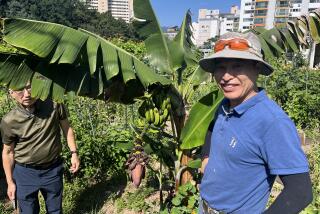Koreans’ Banana Binge Testing Trade Policy : Commerce: As wages and standards of living rise, so does demand for farm products. The government is easing protectionist import curbs.
- Share via
SEOUL — Fearing that the market for its home-grown fruits might be imperiled, South Korea for decades looked with trepidation upon foreign-grown bananas.
So stringent were restrictions against imported bananas that about 2,000 ingenious farmers in southern Korea started raising the fruit in greenhouses, using electricity or oil heating. The costs were prohibitive, but import curbs ensured profits.
The banana became a luxury--a government-created “forbidden fruit.” Korean tourists carried home bunches of bananas they bought on overseas trips. Street vendors--selling frequently half-rotten bananas at prices of about $1.50 apiece--sprang up throughout Seoul. Fruit dishes including bananas became a symbol of elegance at expensive nightclubs.
Indeed, the lowly banana became a hallmark of agricultural protectionism in South Korea, where emotions against farm imports run deeper and often more violent than in neighboring Japan.
Now, a quarter of a century after Japan liberalized its banana imports, South Korea has followed suit. And although prices remain high, long-starved banana lovers are chomping them up by the ton load, as well as by the piece.
The explosion in demand for bananas underscores the continuing growth in South Korea’s market for farm products as wages and standards of living rise here.
And bananas promise to test the mettle of the government’s commitment to agricultural market opening, which the United States has sought for years. The Seoul government recently announced that by 1994, 131 agricultural and fishery products will be removed from a list of banned imports. Restrictions on such products as sugar, pork, peaches and plums will be phased out during the next three years, but 142 agricultural and fishery products will still be on the restricted list.
The South Korean government abolished its quota system on bananas Jan. 1. That system had restricted imports to a mere 20,000 tons last year.
Through late March, imports reached 41,000 tons, “almost twice the volume of domestic production last year,” said Kim Han Gon, an assistant minister of agriculture. By year-end, 250,000 tons of imports are expected, he added.
So great is demand that Japanese trading companies are diverting supplies usually bound for Japan to South Korea, causing prices in Japan to rise.
“Supplies always flow to a market where the prices are higher,” said a Sumitomo Trading Co. spokesman in Tokyo.
Since January, banana prices in Japan have risen 10 cents to 82 cents a pound. But in South Korea, a pound of bananas is selling for $2.02, thanks to a 90% tariff, raised from last year’s 50%. Bananas are also sold by the piece--from 56 cents to 97 cents each, depending on size.
Even so, South Korean importers can’t obtain all the bananas they would like to import. A poor harvest in the Philippines and the failure of banana growers elsewhere to anticipate the Korean surge in demand has pinched supplies, said Kim Jae Il, president of the Yungsung Industrial Co., a firm exporting and importing fruits and vegetables.
“Even I did not expect this kind of growth,” Kim said.
Many agree that bananas will affect the prices of other fruit grown in South Korea. Much fruit is sold as gifts, and fancy-wrapped bananas are expected to eat into the gift market for domestic fruit, they explained.
So far, a poor harvest in South Korea has sustained high prices of domestic fruit. But if prices fall later, it could spell trouble.
In the past, expanded imports have precipitated cow manure-throwing protests by beef farmers, a consumer group-initiated boycott against American cigarettes and a suit against foreign popcorn.
Last fall, a semi-government agricultural group produced 600,000 comic books describing food imports as laced with dangerous chemicals and additives and “bad for your health” and distributed them to schools around the country. The comic book summed up its appeal to the children by saying, “Let’s go to the grocery store with Mommy to make sure she doesn’t buy foreign food.”
Importer Kim said he found himself in a “sensitive” position. “Some people say, ‘What’s a little banana? It won’t hurt the economy,’ ” Kim said. “But others say, ‘Why do you have to import bananas? We can do without bananas.’ ”
Kim of the Agricultural Ministry said demand could peak at 500,000 tons a year. Importer Kim said the market might grow even bigger than that, but he expressed confidence that the government would not step in to halt the growth.
Bureaucrat Kim, however, said only that “after the first year, we’ll take a look at consumption patterns” and decide what to do.
More to Read
Sign up for Essential California
The most important California stories and recommendations in your inbox every morning.
You may occasionally receive promotional content from the Los Angeles Times.













